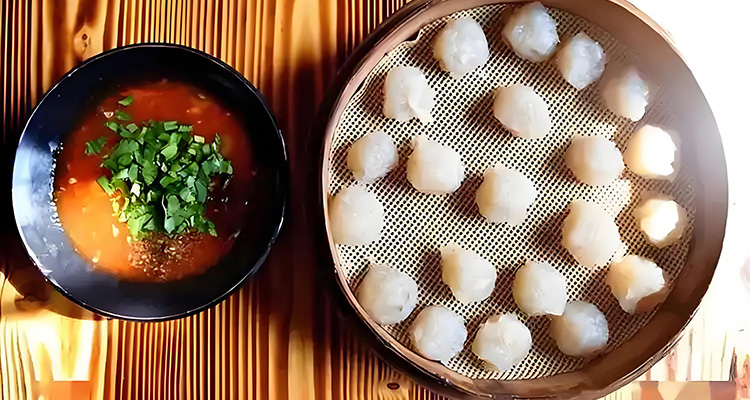He Lengzi: Lüliang Potato Dumplings
A soft, chewy bite that carries a century of home memories — He Lengzi is a humble potato snack from Shanxi’s Lüliang mountains that tells the story of land, family, and survival.
1. Origin and History: A Smart Food from the Loess Plateau
He Lengzi was born out of the rugged terrain and harsh farming conditions of Lüliang on China’s Loess Plateau. Potatoes — drought-tolerant and prolific — became a staple here, and resourceful locals turned this simple tuber into many dishes. He Lengzi, literally meaning a small round dumpling made by joining and shaping mashed potatoes, likely dates back to the Ming and Qing eras when families needed practical, filling foods that stretched limited supplies.
The name carries local warmth: in regional dialects, he and leng evoke ideas of joining and reunion. Each small potato ball symbolizes family togetherness and the quiet hopes of rural households.
2. Cultural Significance: Taste of Home and Memory
More than just a snack, He Lengzi is woven into Lüliang’s cultural fabric. For many locals, the scent of steamed potatoes signals family gatherings, and older generations recall mothers shaping dumplings by hand over the stove. During festivals and important family events, He Lengzi often appears on the table as a symbol of reunion and comfort.
For emigrants from Lüliang, a single taste can trigger vivid nostalgia — the aroma, texture, and simple seasoning are direct links to childhood kitchens and ancestral rhythms.
3. Ingredients: Simple, Honest, Regional
The ingredient list is remarkably short: potatoes and starch. But simplicity hides subtlety. Potatoes grown in the Lüliang region develop a dense, slightly sweet flesh thanks to the dry climate and mineral-rich loess soil, making them perfect for mashing.
Locals typically use yellow-skinned potatoes and mix in potato or sweet potato starch to bind the mash. The starch ratio determines the texture: enough to hold shape, but not so much that the dumpling loses the potato’s natural flavor.

4. Making He Lengzi: A Hands-On Tradition
Making He Lengzi is a small art passed down through families. First, choose firm, high-starch potatoes, wash, and steam them to preserve aroma and nutrients. While still hot, peel and mash them finely — a mortar and pestle give a silkier texture than a fork. Gradually add starch and knead until the dough is smooth and non-sticky.
Pinch off small portions and roll them into 3 cm balls. Steam the balls for 15–20 minutes or boil until they float — that’s how you know they’re done. The correct starch-to-potato balance and gentle handling are what give He Lengzi its signature soft yet springy — or “Q” — texture.
5. Flavor and Texture: Soft, Chewy, Potato-Sweet
Freshly cooked He Lengzi are translucent and glossy with a clean potato fragrance. The outer layer is tender while the inside remains soft and slightly elastic. The best ones strike a balance between meltingly soft and pleasantly chewy — not mushy, not rubbery.
Because the dumplings themselves are subtly flavored, they become an excellent base for a variety of dipping sauces, showcasing regional condiments and personal tastes.
6. How to Eat: Classic and Creative Pairings
The classic local pairing is homemade tomato sauce: slow-simmered fresh tomatoes create a tangy-sweet contrast to the dumplings’ mildness. Another beloved match is Shanxi aged vinegar — rich, malty, and slightly smoky — which adds a bright, complex balance.
Spice lovers drizzle chili oil or mix in crushed garlic for heat and depth. In restaurants, you may also find He Lengzi served in braised dishes with vegetables and meat, where they soak up savory broths and gain a new depth of flavor.
7. Tips for Tasting: Local Secrets
To taste the most authentic He Lengzi, seek out farmhouse inns or small family-run eateries in Lüliang. Try the plain dumpling first to appreciate the potato’s natural sweetness, then sample it with tomato sauce and Shanxi vinegar.
Eat them hot — freshly steamed He Lengzi offer the best “Q” texture. If allowed to cool, they remain tasty but lose a bit of their springiness.

8. Traveler Advice: When and Where to Try Them
Spring and autumn are the best seasons to visit Lüliang: the mild weather makes village visits comfortable and local markets lively. While many restaurants across the region serve He Lengzi, the most authentic versions are often found in countryside homes, old-town taverns, and small alleyway diners in places like Lishi and Xiaoyi.
Look for family-style eateries where dumplings are handmade daily. Some communities even host workshops where visitors can mash, shape, and steam their own He Lengzi — a warm, hands-on cultural experience.
9. Home Recipe: Bring Lüliang Home
You can recreate a simple version at home: steam high-starch potatoes until tender, peel and mash thoroughly, then mix three parts mashed potato to one part potato starch by volume. Knead until smooth, roll into small balls, and boil until they float. Serve immediately with tomato sauce, aged vinegar, or chili oil.
Conclusion
He Lengzi is more than a potato recipe — it’s a small edible archive of Lüliang life. Its modest ingredients and tactile preparation remind us that food can be both nourishment and memory. When you travel to Shanxi, seek out this soft, chewy treasure: one bite connects you to rural kitchens, family stories, and the enduring comfort of home.


